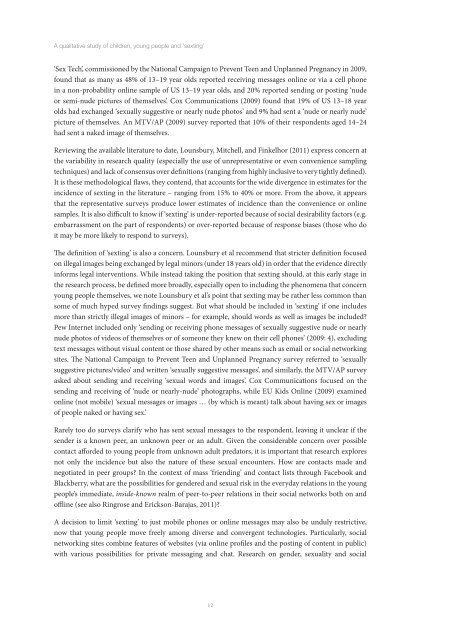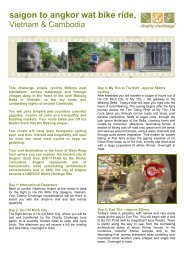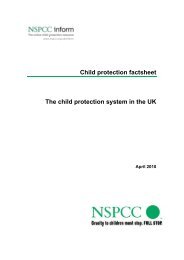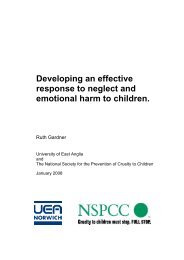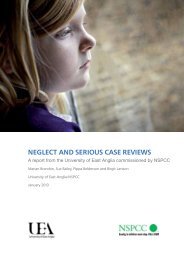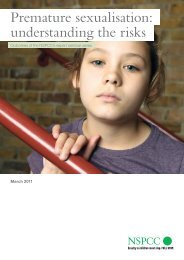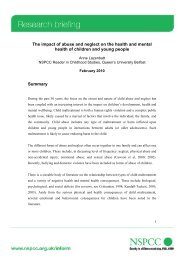A qualitative study of children, young people and 'sexting ... - NSPCC
A qualitative study of children, young people and 'sexting ... - NSPCC
A qualitative study of children, young people and 'sexting ... - NSPCC
You also want an ePaper? Increase the reach of your titles
YUMPU automatically turns print PDFs into web optimized ePapers that Google loves.
A <strong>qualitative</strong> <strong>study</strong> <strong>of</strong> <strong>children</strong>, <strong>young</strong> <strong>people</strong> <strong>and</strong> ‘sexting’<br />
‘Sex Tech’, commissioned by the National Campaign to Prevent Teen <strong>and</strong> Unplanned Pregnancy in 2009,<br />
found that as many as 48% <strong>of</strong> 13–19 year olds reported receiving messages online or via a cell phone<br />
in a non-probability online sample <strong>of</strong> US 13–19 year olds, <strong>and</strong> 20% reported sending or posting ‘nude<br />
or semi-nude pictures <strong>of</strong> themselves’. Cox Communications (2009) found that 19% <strong>of</strong> US 13–18 year<br />
olds had exchanged ‘sexually suggestive or nearly nude photos’ <strong>and</strong> 9% had sent a ‘nude or nearly nude’<br />
picture <strong>of</strong> themselves. An MTV/AP (2009) survey reported that 10% <strong>of</strong> their respondents aged 14–24<br />
had sent a naked image <strong>of</strong> themselves.<br />
Reviewing the available literature to date, Lounsbury, Mitchell, <strong>and</strong> Finkelhor (2011) express concern at<br />
the variability in research quality (especially the use <strong>of</strong> unrepresentative or even convenience sampling<br />
techniques) <strong>and</strong> lack <strong>of</strong> consensus over definitions (ranging from highly inclusive to very tightly defined).<br />
It is these methodological flaws, they contend, that accounts for the wide divergence in estimates for the<br />
incidence <strong>of</strong> sexting in the literature – ranging from 15% to 40% or more. From the above, it appears<br />
that the representative surveys produce lower estimates <strong>of</strong> incidence than the convenience or online<br />
samples. It is also difficult to know if ‘sexting’ is under-reported because <strong>of</strong> social desirability factors (e.g.<br />
embarrassment on the part <strong>of</strong> respondents) or over-reported because <strong>of</strong> response biases (those who do<br />
it may be more likely to respond to surveys).<br />
The definition <strong>of</strong> ‘sexting’ is also a concern. Lounsbury et al recommend that stricter definition focused<br />
on illegal images being exchanged by legal minors (under 18 years old) in order that the evidence directly<br />
informs legal interventions. While instead taking the position that sexting should, at this early stage in<br />
the research process, be defined more broadly, especially open to including the phenomena that concern<br />
<strong>young</strong> <strong>people</strong> themselves, we note Lounsbury et al’s point that sexting may be rather less common than<br />
some <strong>of</strong> much hyped survey findings suggest. But what should be included in ‘sexting’ if one includes<br />
more than strictly illegal images <strong>of</strong> minors – for example, should words as well as images be included?<br />
Pew Internet included only ‘sending or receiving phone messages <strong>of</strong> sexually suggestive nude or nearly<br />
nude photos <strong>of</strong> videos <strong>of</strong> themselves or <strong>of</strong> someone they knew on their cell phones’ (2009: 4), excluding<br />
text messages without visual content or those shared by other means such as email or social networking<br />
sites. The National Campaign to Prevent Teen <strong>and</strong> Unplanned Pregnancy survey referred to ‘sexually<br />
suggestive pictures/video’ <strong>and</strong> written ‘sexually suggestive messages’, <strong>and</strong> similarly, the MTV/AP survey<br />
asked about sending <strong>and</strong> receiving ‘sexual words <strong>and</strong> images’. Cox Communications focused on the<br />
sending <strong>and</strong> receiving <strong>of</strong> ‘nude or nearly-nude’ photographs, while EU Kids Online (2009) examined<br />
online (not mobile) ‘sexual messages or images … (by which is meant) talk about having sex or images<br />
<strong>of</strong> <strong>people</strong> naked or having sex.’<br />
Rarely too do surveys clarify who has sent sexual messages to the respondent, leaving it unclear if the<br />
sender is a known peer, an unknown peer or an adult. Given the considerable concern over possible<br />
contact afforded to <strong>young</strong> <strong>people</strong> from unknown adult predators, it is important that research explores<br />
not only the incidence but also the nature <strong>of</strong> these sexual encounters. How are contacts made <strong>and</strong><br />
negotiated in peer groups? In the context <strong>of</strong> mass ‘friending’ <strong>and</strong> contact lists through Facebook <strong>and</strong><br />
Blackberry, what are the possibilities for gendered <strong>and</strong> sexual risk in the everyday relations in the <strong>young</strong><br />
<strong>people</strong>’s immediate, inside-known realm <strong>of</strong> peer-to-peer relations in their social networks both on <strong>and</strong><br />
<strong>of</strong>fline (see also Ringrose <strong>and</strong> Erickson-Barajas, 2011)?<br />
A decision to limit ‘sexting’ to just mobile phones or online messages may also be unduly restrictive,<br />
now that <strong>young</strong> <strong>people</strong> move freely among diverse <strong>and</strong> convergent technologies. Particularly, social<br />
networking sites combine features <strong>of</strong> websites (via online pr<strong>of</strong>iles <strong>and</strong> the posting <strong>of</strong> content in public)<br />
with various possibilities for private messaging <strong>and</strong> chat. Research on gender, sexuality <strong>and</strong> social<br />
12


